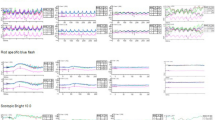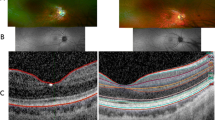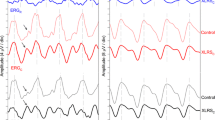Abstract
ERG findings in five sisters are reported. By pedigree analysis, four of the five must be obligate carriers for I-CSNB since their sons were affected (impaired night vision, reduced visual acuity, variable ametropia, congenital nystagmus and ERG with both scotopic and photopic b-wave reduced amplitude). The fifth was childless at the time of examination and her ERG analysis was normal. Three of the four obligate carriers showed significant reduction in the sum of the OPs amplitude as previously reported as being an electrophysiological signs in female carriers: two without alteration in other ERG components and the third with association with a flicker ERG amplitude significantly increased. The fourth female carrier showed a normal sum of the OPs amplitude whereas the other b-wave ERG or flicker amplitudes were significantly decreased. These last two ERG results suggest a possible modifications of synaptic transmission at a post-receptoral site (outer plexiform layer or involvement of the bipolar pathways) in these two carriers.
Similar content being viewed by others
References
Miyake Y, Kawase Y. Reduced amplitude of oscillatory potentials in female carriers of X-linked recessive congenital stationary night blindness. Am J Ophthalmol 1984; 98(2): 208-215.
Young RS, Chaparro A, Price J, Walters J. Oscillatory potentials of X-linked carriers of congenital stationary night blindness. Invest Ophthalmol Vis Sci 1989; 30(5): 806-812.
Ruttum MS, Lewandowski MF, Bateman JB. Affected females in X-linked congenital stationary night blindness. Ophthalmology 1992; 99(5): 747-752.
Lorenz B, Andrassi M, Miliczek KD. Incomplete congenital stationary night blindness (CSNB). An important differential diagnosis of congenital nystagmus. Klin Monatsbl Augenheilkd 1996; 208(1): 48-55.
Marmor MF, Zrenner E. Standard for clinical electroretinography (1999 update). Doc Ophthalmol 1999; 97: 143-156.
Miyake Y, Yagasaki K, Horiguchi M, Kawase Y, Kanda T. Congenital stationary night blindness with negative electroretinogram. A new classification. Arch Ophthalmol 1986; 104: 1013-1020.
Miyake Y, Horiguchi M, Ota I, Shiroyama N. Characteristic ERG-flicker anomaly in incomplete congenital stationary night blindness. Invest Ophthalmol Vis Sci 1987; 28(11): 1816-1823.
Bush RA, Sieving PA. Inner retinal contributions to the primate photopic fast flicker electroretinogram. J Opt Soc Am A 1996; 13(3): 557-565.
Kondo M, Sieving PA. Primate photopic sine-wave flicker ERG: vector modeling analysis of component origins using glutamate analogs. Invest Ophthalmol Vis Sci 2001; 42(1): 305-312.
Barnes CS, Alexander KR, Fishman GA. A distinctive form of congenital stationary night blindness with cone ON-pathway dysfunction. Ophthalmol 2002; 109(3): 575-583.
Alexander KR, Barnes CS, Fishman GA, Milam AH. Nature of the cone ON-pathway dysfunction inMelanoma-Associated Retinopathy. Invest Ophthalmol Vis Sci 2002; 43(4): 1189-1197.
Krill AE. X-chromosomal linked diseases affecting the eye. Status of the heterozygote female. Trans Am Ophthalmol Soc 1969; 67: 535.
Karwoski CJ, Xu X. Current source-density analysis of lightevoked field potentials in rabbit retina. Visual Neuroscience 1999; 16: 369-377.
Alexander KR, Fishman GA, Grover S. Temporal deficits in the electroretinogram of the cone system in X-linked retinoschisis. Vision Res 2000; 40: 2861-2868.
Usui T, Kremers J, Sharpe LT, Zrenner E. Response phase of the flicker electroretinogram (ERG) is influenced by cone excitation strength. Vision Res 1998; 38(21): 3247-3251.
Scholl HP, Kremers J. Large phase differences between L-cone and M-cone-driven electroretinograms in retinitis pigmentosa. Invest Ophthalmol Vis Sci 2000; 41(10): 3225-3233.
Scholl HPN, Kremers J, Vonthein R, White K, Weber BHF. Land M-cone-driven electroretinograms in Stargardt's macular dystrophy-fundus flavimaculatus. Invest Ophthalmol Vis Sci 2001; 42(6): 1380-1389.
Scholl HPN, Kremers J, Apfelstedt-Sylla E, Zrenner E. Land M-cone-driven electroretinograms are differently altered in Best's macular dystrophy. Vision Res 2000; 40: 3159-3168.
Boycott KM, Pearce WG, Musarella MA, Weleber RG, Maybaum TA, Miyake Y, Young RS, Bech-Hansen NT. Evidence for genetic heterogeneity in X-linked congenital night blindness. Am J Hum Genet 1998; 62(4): 865-875.
Bech-Hansen NT, Boycott KM, Gratton KJ, Ross DA, Field LL, Pearce WG. Localization of a gene for incomplete Xlinked congenital stationary night blindness to the interval between DXS6849 and DXS8023 in Xp11.23. Hum Genet 1998; 103(2): 124-130.
Bech-Hansen NT, Naylor MJ, Maybaum TA, Pearce WG, Koop B, Fishman GA, Mets M, Musarella MA, Boycott KM. Loss-of-function mutations in a calcium-channel alpha-1-subunit gene in Xp11.23 cause incomplete X-linked congenital stationary night blindness. Nature Genet 1998; 19: 264-267.
Nakamura M, Ito S, Terasaki H, Miyake Y. Novel CACNA1F mutations in Japanese patients with incomplete congenital stationary night blindness. Invest Ophthalmol Vis Sci 2001; 42(7): 1610-1616.
Boycott KM, Pearce WG, Bech-Hansen NT. Clinical variability among patients with incomplete X-linked congenital stationary night blindness and a founder mutation in CACNA1F. Can J Ophthalmol 2000; 35(4): 204-213.
Witzel DA, Smith EL, Wilson RD, Aguirre GD. Congenital Stationary Night Blindness: an animal model. Invest Ophthalmol Vis Sci 1978; 17: 788-795.
Rebhun WC, Loew ER, Riis RC, Laratta LJ. Clinical manifestations of night blindness in the Appaloosa Horse. Comp of Cont Ed Vet 1984; 6: 103-106.
Narfström K, Wrigstad A, Ekesten B, Nilsson SE. Hereditary retina dystrophy in the Briard dog: clinical and hereditary characteristics. Vet and Comp Ophthalmol 1994; 4(2): 85-92.
Witzel DA, Joyce JR, Smith EL. Electroretinography of congenital night blindness in an Appaloosa filly. J of Equine Med Surg 1977; 1: 226.
PardueMT,McCallMA, LaVailMM, Gregg RG, Peachey NS. A naturally occurring mouse model of X-linked Congenital Stationary Night Blindness. Invest Ophthalmol Vis Sci 1998; 39: 2443-2449.
Zhang Z, Gu Y, Li L, Long T, Guo Q, Shi L. A spontaneous gene mutant rat model of CSNB. ISCEV 2002; Abstract p. 65.
Author information
Authors and Affiliations
Rights and permissions
About this article
Cite this article
Rigaudière, F., Roux, C., Lachapelle, P. et al. ERGs in female carriers of incomplete Congenital Stationary Night Blindness (I-CSNB) A family report . Doc Ophthalmol 107, 203–212 (2003). https://doi.org/10.1023/A:1026212318245
Issue Date:
DOI: https://doi.org/10.1023/A:1026212318245




